What Size Wire For 50 Amp Welder
Welders draw large amounts of electricity and require loftier-capacity connectors to pass the electrical current needed for welding.
As studies say, proper wiring is a must for electrical equipment. When the quality of wiring is a matter of life or death — as it is with a welder — you need to be very precise and use the right connectors for the job.
In this guide we show you how to properly wire a 50-amp plug for a welder without melting the machine or electrocuting yourself. This includes:
- What equipment you'll need to wire a fifty-amp plug for a welder
- What size wire yous need for unlike welder sizes
- What size circuit breaker you demand for different welder sizes
- How to wire a 50-amp plug for your welder

What Equipment Do Yous Need to Wire a 50-Amp Plug for a Welder?
Here'southward a list of tools and equipment you will demand to wire a 50-amp plug for a welder:
- The correct AVG gauge and length of wire to power your welder
- The correct two-pole or 3-pole circuit billow (mounted in billow box)
- Affluent mountain gang box OR external outlet box for the plug
- NEMA half dozen-50P 3-prong 240-volt 50-amp outlet
- Outlet cover
- Voltage tester
- Adhesive electrical insulation tape
- Cable ripper
- Wire stripper
- Screwdriver
- Box cutter or electrician'south knife
- Prophylactic glasses
- Rubber electrician'southward gloves
- Condom soled shoes
What Size Power Cable Do You Demand for a Welder?
The first consideration before wiring in your fifty-amp plug is to choose the correct size electrical cablevision to power the plug. Sizing the input wiring to ability a welder is done based on the specific current requirements of your welder.

If the cable carrying electricity to the plug that powers your welder is too small, it overheat and melt the insulation. This can crusade a short circuit, leading to a potential fire. It'south very bad if you don't use large enough electrical wire to power your welder.
On the other hand, there is no negative affect from using oversize cable. The larger wiring will deport the electric current fine with no issues. The just downside is the boosted cost of heavier copper and connectors. In fact, if you lot plan to run big power tools, a pump or compressor off the same plug you're using for welding, then you should consider going to a higher gauge electrical wire. This will give yous flexibility and enough of condom current capacity for your welder.
Here's a table of copper wire gauges required for welders with different input amperages:
| Maximum Welder Amperage Draw | Wire Gauge (AWG) |
| xxx | 10 |
| forty | 8 |
| 50 | 6 |
| sixty | four |
For almost 220-volt welders 6-gauge wiring to the power plug volition exist sufficient. For a small 110-volt hobby welder y'all're usually fine with 10 judge wire.
220-volt welders generally use a 3-prong plug in the United States. Two of the prongs carry 110 volts each for a total of 240 volts. The tertiary prong is a neutral or ground line. Information technology's essential to connect these three wires correctly or all kinds of catastrophic things volition happen when you plough the power on!
Table 310-sixteen of the National Electrical Code specifies the wire sizes required for specific current draws. If the table above doesn't give you the answer you need, we recommend checking out the NEC specifications.
What Size Circuit Billow Exercise You Demand for a Welder?
The amount of input current required to power your welder determines the circuit billow size you need.
As a general dominion a 220-volt welder drawing 40-fifty input amps requires a fifty-amp circuit breaker. A 110-volt welder drawing 20-30 input amps requires a 30-amp circuit breaker.
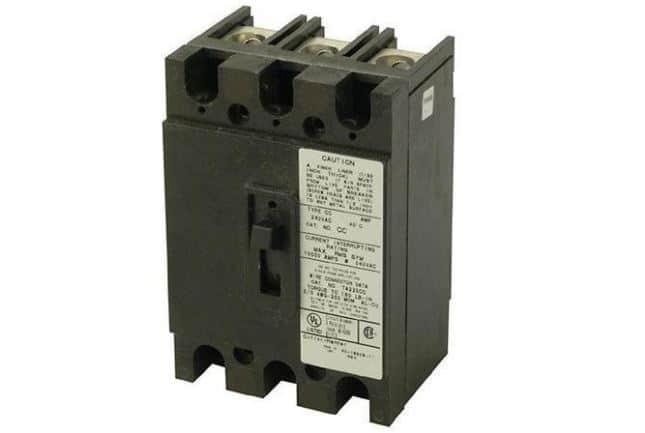
The circuit breaker is the prophylactic mechanism that volition trip and shut off the current in the consequence of a short or electrical overload past your welder. Excursion breakers should be mounted in a billow box near the shop surface area where you're welding.
Selecting the right circuit breaker and wiring it into the breaker box properly requires a certified electrician. This is NOT something an apprentice should practise because whatever errors tin can easily lead to burning downwards your building with an electrical burn down.
How To Wire a 50-Amp Plug for a Welder
One time you've got your circuit breaker installed, information technology's time to swoop in and wire up your 50-amp plug for your welder.
Notation: We show you how to wire in a 3-prong NEMA 6-50P which is the virtually common 220-volt welder plug / receptacle format in the United States. Many 220- or 240-volt household washer-dryer outlets utilize a iii flat angled prong plug format (NEMA 10-30P/10-50P). If yous desire to use the outlet for a washer-dryer then you should wire in a NEMA 10-30P/ten-50P outlet and combine it with a NEMA half-dozen-l-P adapter to run your welder.
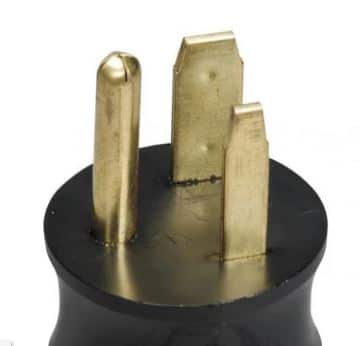
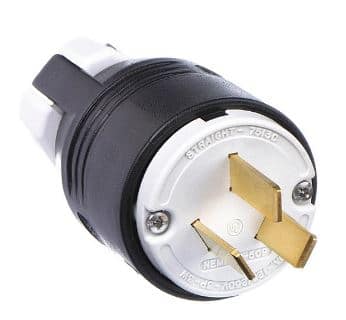
Footstep 1: Condom FIRST! Turn off the main power
Earlier you lot offset running wire betwixt the billow box and your outlet, close down the main power supply to the main breaker box. This should be a large lever. Then switch the master excursion breaker off too, just in case.
Next, put on your safety glasses, rubber electrician's gloves and rubber soled shoes. The man body is a good conductor of electricity and you lot don't need to exist a lightning rod for the solar day!
Finally, to be 100% sure the ability is off, utilise your voltage tester, holding i probe against the neutral bus bar and the other probe to both screws on a excursion breaker. Do Non touch the big black cables running into the main circuit breaker — these are ever on and could give you a huge shock!
Step 2: Wire into the circuit breaker box
Annotation: This assumes you are running a 120/240-volt excursion with 2 hot wires (normally red and black) and a white neutral wire. A straight 240-volt circuit will have 2 hot wires and a blank ground wire.
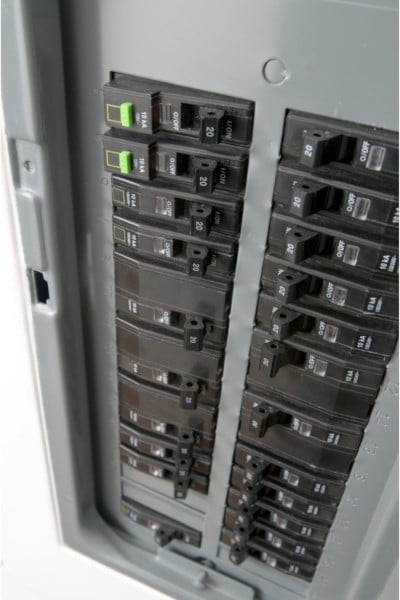
Remove the breaker box console cover to betrayal the excursion breakers. Pull the new circuit breaker out of its slot (or get a new one) so you can access its terminals.
Strip off the outer sheath of your iii-wire cablevision using your cablevision ripper, exposing the iii inner wires for about a pes or then. Then strip the insulation of the white neutral wire and the two hot wires back most one/2 inch.
Identify the twoscore- or 50-amp excursion breaker you want to wire your plug into. Run your cable into a cable clamp in the box so there is about ane inch of outer sheathing and a human foot of inner wires inside the box.
There should be existing white neutral wires screwed into the neutral bus bar. Select a new terminal in that bus bar and spiral in your white neutral wire.
Adjacent, insert the red and black hot wires into the 2 terminals on your circuit breaker. Tighten down the terminal screws.
Step three: Install the circuit breaker and panel cover
Slide the circuit breaker into a slot in the billow box with the hot wires forth the hot motorcoach bar. This should exist obvious as other breakers with their carmine and black hot wires will be pointing the same direction. Snap the circuit billow into place so it's flush.
Organize the wires and then they are away from the hot bus bar. Then put the box's panel cover back on as it was earlier and reinstall any screws.
Step 4: Run cable to your outlet location
On the other side of the wall from the breaker box, start threading your 3-wire cable through the wall or electrical conduit mounted on the exterior of the wall.
If you're going through the wall you lot may need to drill holes in the studs and pass the cable through them. If necessary, remove any wallboard in narrow strips to give you access. Save the wallboard pieces to reinstall later.
Whichever route you take, make certain you lot're post-obit any necessary codes and regulations. As well be careful not to pinch the cable or run it directly over other metal or sharp corners where it could become damaged and brusk out.
Step five: Install the 50-amp outlet for your welder
Your 50-amp NEMA 6-50P outlet receptacle should look like the one below. The plug receptacle and face plate mount on the front of the box.
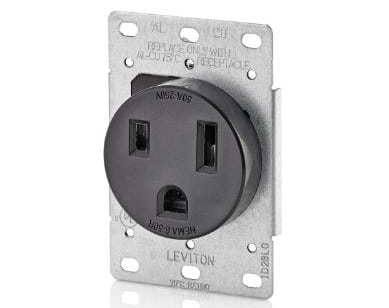
If you're installing your outlet affluent in the wall, then you volition demand to spiral your gang box to a stud and cutting out a rectangle in the wallboard for the outlet cover. If yous're using an external box then you lot need to mount it to the wall and run your electrical conduit into it.
Once yous've got the box installed, run your cablevision into the primary input / output pigsty. Strip off well-nigh 6-8 inches of the outer sheath off your cablevision. Then strip 1/2 inch of insulation off each wire.
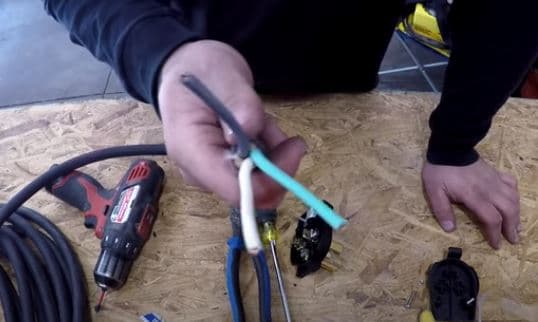
Next, wire your ii hot wires into the left and right outlet terminals of the 6-50P plug as shown in the wiring diagram below. The white neutral or ground wire should exist continued to the heart concluding of the plug.
Be sure to screw all your wires down securely and brand certain the wires don't contact each other inside the receptacle box.
Step 6: Test the new fifty-amp welder plug
Now it'south time to test the plug to see if it is functioning properly. Plough on the main ability and circuit breaker at the billow box. Plug your welder into plug. And then press the power button on the welder and run a test weld on a minor piece of metal. If all is OK then just screw downwardly the outlet cover and you're skillful to go!

Final Thoughts
Wiring in a 50-amp plug for a welder can be quite simple when you know how to connect the outlet plug and the breaker correctly. By following these steps thoroughly, anyone with some skill should be able to install a new 50-amp plug for a welder with only a few tools. The key is taking the right safety precautions.
Did you find this useful? If yes please share!
What Size Wire For 50 Amp Welder,
Source: https://selectsafety.net/wire-50-amp-plug-for-welder/
Posted by: nashpitand.blogspot.com


0 Response to "What Size Wire For 50 Amp Welder"
Post a Comment